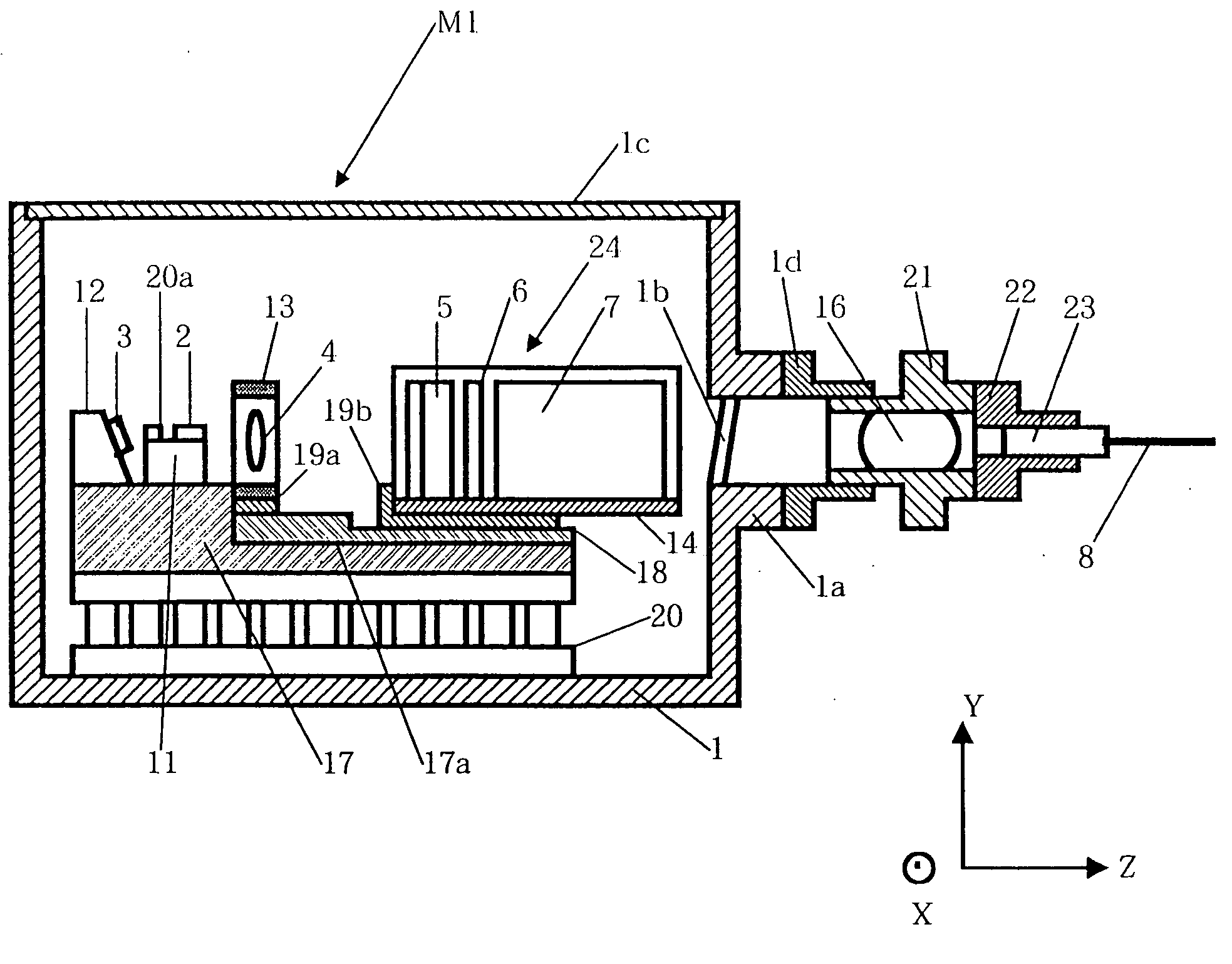Method of aligning an optical fiber, method of manufacturing a semiconductor laser module, and semiconductor laser module
a technology of laser module and optical fiber, which is applied in the direction of semiconductor lasers, instruments, record information storage, etc., can solve the problems of large size of semiconductor laser modules, long manufacturing time, complicated manufacturing process, etc., and achieve the effect of easy alignmen
- Summary
- Abstract
- Description
- Claims
- Application Information
AI Technical Summary
Benefits of technology
Problems solved by technology
Method used
Image
Examples
first embodiment
[0137] (First Embodiment)
[0138]FIG. 1 is a side sectional view showing a configuration of a semiconductor laser module manufactured by a method in accordance with a first embodiment of the present invention.
[0139] As shown in FIG. 1, a semiconductor laser module M1 manufactured by the method in accordance with the first embodiment of the present invention includes a package 1 whose interior is hermetically sealed, a semiconductor laser device 2 encased in the package 1 for emitting laser beam, a photodiode (light receiving element) 3, a first lens 4, a prism 5, a half-wave plate (a polarization rotating element) 6, a PBC 7 as a polarization synthesis elemenet, and an optical fiber 8.
[0140] The semiconductor laser device 2 includes, as shown in FIG. 5, a first stripe 9 and a second stripe 10 disposed at a distance on the same plane and extending in parallel in the longitudinal direction. The semiconductor laser device 2 emits a first laser beam K1 and a second laser beam K2 respect...
second embodiment
[0179] (Second Embodiment)
[0180]FIG. 9 is a plan view showing a semiconductor laser module M6 according to a second embodiment of the present invention. As shown in FIG. 9, the semiconductor laser module M2 according to the second embodiment of the present invention includes: a first semiconductor laser device 38 for emitting a first laser beam K1; a second semiconductor laser device 39 for emitting a second laser beam K2; two first lenses 40 and 41 on which the two laser beams K1 and K2 emitted from the two semiconductor laser devices 38 and 39 are incident, respectively; a cube beam splitter 42 as a polarization synthesis elemenet; and a mirror 43 as a reflector that reflects the laser beam K2 toward the cube beam splitter 42. The other structure is the same as that of the first embodiment.
[0181] In the second embodiment of the present invention, the second laser beam K2 enters the cube beam splitter 42 through the mirror 43. Therefore, a light path of the first laser beam K1 and...
third embodiment
[0191] (Third Embodiment)
[0192]FIG. 10 is a plan view showing a semiconductor laser module according to a third embodiment of the present invention.
[0193] A semiconductor laser module M3 according to the third embodiment includes: a semiconductor laser device 46 which is an array laser equipped with a first stripe 44 and a second stripe 45 that are parallel to each other across a gap of about 500 μm; a first lens 47 for receiving the first laser beam K1 that is emitted from the first stripe 44; and a first lens 48 for receiving the second laser beam K2 that is emitted from the second stripe 45. The other structure is the same as that of the first embodiment.
[0194] The third embodiment uses the PBC 7 as in the first embodiment. Therefore, a light path of the first laser beam K1 differs from a light path of the second laser beam K2 in optical length, and the distance α1 between the first stripe 44 and the first lens 47 differs from the distance α2 between the second stripe 45 and th...
PUM
| Property | Measurement | Unit |
|---|---|---|
| refractive index n2 | aaaaa | aaaaa |
| refractive index n2 | aaaaa | aaaaa |
| length L2 | aaaaa | aaaaa |
Abstract
Description
Claims
Application Information
 Login to View More
Login to View More - R&D
- Intellectual Property
- Life Sciences
- Materials
- Tech Scout
- Unparalleled Data Quality
- Higher Quality Content
- 60% Fewer Hallucinations
Browse by: Latest US Patents, China's latest patents, Technical Efficacy Thesaurus, Application Domain, Technology Topic, Popular Technical Reports.
© 2025 PatSnap. All rights reserved.Legal|Privacy policy|Modern Slavery Act Transparency Statement|Sitemap|About US| Contact US: help@patsnap.com



